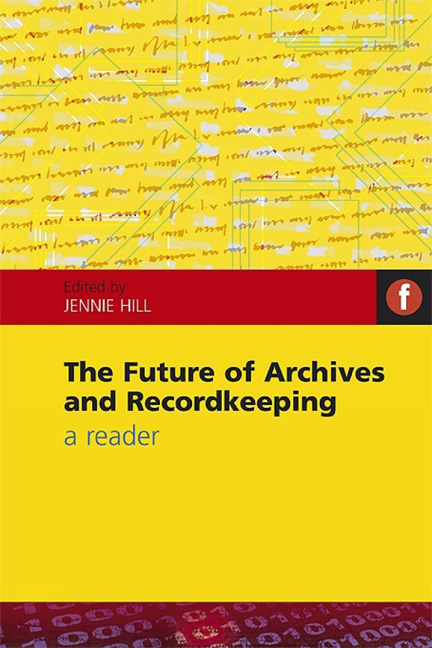Book contents
- Frontmatter
- Dedication
- Contents
- Acknowledgements
- Contributors
- Introduction: seeing the future of archives and recordkeeping
- Part 1 Defining archives
- Part 2 Shaping a discipline
- Part 3 Archive 20: archives in society
- Part 4 Archives in the information age: is there still a role for the archivist?
- 9 The postcustodial archive
- 10 Information management, records management, knowledge management: the place of archives in a digital age
- 11 Appraisal and the future of archives in the digital era
- Index
- Miscellaneous Endmatter
- Miscellaneous Endmatter
- Miscellaneous Endmatter
9 - The postcustodial archive
from Part 4 - Archives in the information age: is there still a role for the archivist?
Published online by Cambridge University Press: 08 June 2018
- Frontmatter
- Dedication
- Contents
- Acknowledgements
- Contributors
- Introduction: seeing the future of archives and recordkeeping
- Part 1 Defining archives
- Part 2 Shaping a discipline
- Part 3 Archive 20: archives in society
- Part 4 Archives in the information age: is there still a role for the archivist?
- 9 The postcustodial archive
- 10 Information management, records management, knowledge management: the place of archives in a digital age
- 11 Appraisal and the future of archives in the digital era
- Index
- Miscellaneous Endmatter
- Miscellaneous Endmatter
- Miscellaneous Endmatter
Summary
Introduction: F. Gerald Ham and the ‘postcustodial era’
In a landmark address to the 1980 annual meeting of the Society of American Archivists, the State Archivist of Wisconsin F. Gerald Ham (1981) presented a set of archival strategies for what he called ‘the postcustodial era’. He characterized archives in the custodial era as being passive and introspective and almost exclusively concerned with the custodial management of archival holdings. He argued lucidly that archives and archivists could not afford to persist with this narrow custodial mindset, especially if they were to both survive the challenges of, and take advantage of, the opportunities presented by automation and the growth of born digital information and online networks.
Ham characterized the postcustodial era as featuring a decentralized computer environment where every individual will become their own records manager. In such an environment, archivists would need to be much more active and interventionist if they were to have any hope of fulfilling their mission. He called for much greater levels of interinstitutional co-operation between archives programmes, the development of strategies for providing easy and centralized access to increasingly complex and decentralized archives, and for greater archival involvement in the process of information creation and management.
Importantly, Ham did not argue that archives should stop managing custodial holdings, but rather that archives needed to expand their repertoire of strategies in order to navigate the increasingly complex realities of the late 20th century. This expansion of archival strategies was not a renunciation of custody, but rather a recognition that custody on its own was insufficient to ensure archival success into the future. Ham was not recommending a ‘non-custodial era’, but a ‘postcustodial era’ where archival programmes and archivist self-image would not be defined by custody alone.
During the 1990s, in the midst of a fevered (sometimes almost panicstricken) discourse on electronic records, Ham's postcustodial vision re-emerged as a divisive fault line in the archival discourse. That it took over a decade for Ham's challenge to be taken up in the discourse itself demonstrated just how prescient his 1980 address really was. Ham's paper proposed a radical new definition of archival methods, one that was probably guaranteed to meet with conservative resistance.
- Type
- Chapter
- Information
- The Future of Archives and RecordkeepingA reader, pp. 177 - 194Publisher: FacetPrint publication year: 2010

